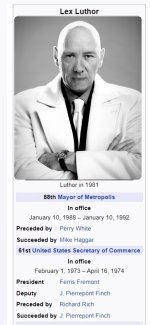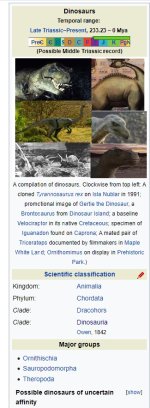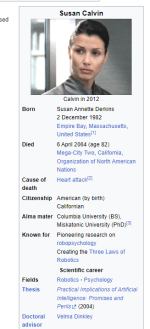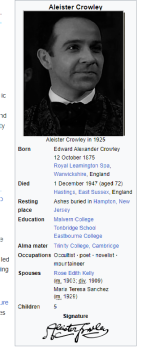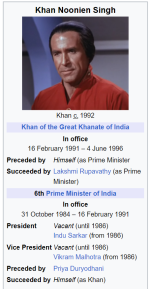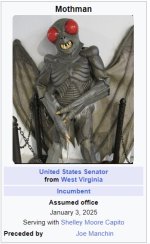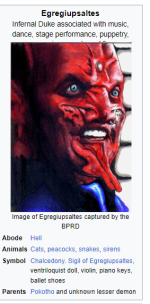Anarcho-Occultist
Well-known member
Kaiju
While technically dating back to the Mesozoic era, overall the phenomenon of kaiju is typically viewed as a fairly modern phenomenon, only emerging with the advent of nuclear weapons on a large scale. Many of the crises associated with kaiju did manifest in smaller amounts in older eras. The rampages of the likes of Typhon, the Kraken or Apophis certainly had a similar impact on societies that suffered from them. And while not as big, the early era was full of giant creatures that often threatened humanity. Dragons are of course the most infamous–while dragons could vary greatly in temperament, attacks by the likes of Smaug or the Red Death certainly could ravage an ancient or medieval city as easily as any modern city suffers from kaiju. The Alteration of the 17th century, triggered by the Brethren Court’s unleashing of Calypso against the East India Trading Company, caused many enormous monsters to emerge from the depths of the ocean and attack land. What all of these older monsters have in common, however, is that they were fueled largely or solely by magical phenomena. When magic faded, the dragons both good and evil, reduced greatly in numbers, to the point that they were pushed to the brink of extinction by the 19th century despite the efforts of Ernest Drake and his acolytes to preserve them. The Alteration eventually was halted and the seas largely calmed. The world was thus largely safe from giant monsters until the 20th century.
The earliest incident involving kaiju was rampage of King Kong in New York City in 1933. Kong was one of the last specimens of a species of ape later dubbed Megaprimatus kong. This was a species that naturally could reach a height of 18 feet. King Kong, notably, exceeded this general height, reaching 24 feet by the time he attacked New York. Scientists have concluded that while this was pre-nuclear in era, Skull Island had a natural uranium deposit that served the mutate the ape to even bigger sizes. After Kong, it would be a couple of decades before the world saw more kaiju on a large scale, aside from the failed experiment of Project Knickerbocker which sought to create irradiated giant monsters as weapons for World War II. In 1953, the world would see the first modern kaiju attack in the form of the Rhedosaurus. A nuclear test carried out under the supervision of Thomas Nesbitt in the Arctic Circle irradiated a frozen dinosaur, causing it to mutate to a vast size. The Rhedosaurus–a species native to the region that is now New York City–proceeded to rampage across much of the Eastern Seaboard, even spreading an ancient pathogen that killed thousands more than its rampage did before being destroyed. The Rhedosaurus would avoid becoming the quintessential kaiju however thanks to another one: Gojira. The infamous kaiju would emerge less than a year later for the first time and devastate much of Tokyo before being apparently destroyed by a superweapon known as the Oxygen Destroyer which likewise was destroyed.
This was the point in time where the world began to take anti-kaiju defense seriously, but the immediate aftermath of Gojira’s attack proved to swamp the world too widely. US nuclear testing lead to kaiju emerging as radiation enlarged ants, rabbits, spiders, molluscs and even a couple of humans (in particular a housewife named Nancy Archer and a colonel named Glenn Manning). The US government sought to cover up the role of its nuclear testing in at least a couple of these cases, trying to pass the kaiju off as natural phenomena or at least consequences of alien incursions. Meanwhile, Japan would see massive amounts of kaiju incursions. A second Gojira, Anguirius, Rodan, Gorgo, the Gargantuas, Reptilicus and Yongary all would emerge in this era. Not all kaiju were the result of nuclear experiments. Some were, instead, extraterrestrial in origin. The Giant Claw, the Blob, Dogora and King Ghidorah were among the more notable of these. Some were simply alien lifeforms who ended up on Earth via happenstance, but Ghidorah and the Blob in particular were explicit weapons of alien invaders. The Blob was a creature created by the Furons as part of their long-running efforts to destroy humanity while Ghidorah was a weapon of the alien race known as the Kilaaks as part of a bid to make invading Earth easy. Oftentimes, these alien kaiju would have to be opposed by the Earth-native ones, which was a key factor in moving kaiju defense away from trying to wipe out all of them and more towards containment. The creation of the Monsterland preserve was intended to provide a refuge for Earth-native kaiju who could combat the threat of extraterrestrial kaiju. Monsterland’s creation was also prompted by the fact that not all kaiju of either variant were inherently malevolent. While the being Gamerra was originally threatening on first emerging, Gamerra was originally created to serve and defend Earth and would regain his original purpose after a few years. Mothra too was a more mystical creature, but was loyal to a population of fae in Japan who wanted to avoid large-scale destruction. Other kaiju benefited from close relationships with humanity–Daigoro and Clifford were both kaiju whose destructive potential was averted by friendly relationships with specific humans. Even the second Gojira eventually proved to be more of a defender of Earth than enemy of it, playing a key role in defeating Cthulhu in 1984 following the Soviet attempt to awaken the entity.
Despite this, the recurring destruction caused by kaiju did lead to wide-scale adoption of contingencies aimed at them specifically. Japan in particular invested heavily in resources to defend against giant monster attacks. The creation of size-changing technology that led to the empowerment of Jet Jaguar and Masuru Daisato allowed for humans to directly fight kaiju. Even more useful was the development of mechas by the Japanese. While the Getter Robos originally were created to combat the subterranean Dinosaur Empire, they proved to be able defenders against kaiju attacks, as did Juzo Kabuto’s Japanium-derived mech Mazinger Z. These developments would pave the way for the eventual development of more sophisticated anti-kaiju defenses to be established. In 2008, an entity dubbed ‘Clover’ attacked New York City, devastating the place. The most worrisome thing about this kaiju was its lack of a clear origin. It is now believed Clover originated from a parallel reality where it was engineered from species from another reality dominated by unusual lifeforms naturally similar to kaiju (which had been discovered by the US in 1946) as a deliberate weapon of extradimensional aliens (perhaps the Combine Empire). In 2015, a rift to this reality was opened in the Pacific Ocean and kaiju attacks across the Pacific would once again spike. This prompted the creation of the Pan-Pacific Defense Corps and the commissioning of Jaegers, a particular form of mecha requiring two pilots and adept at combating attacking kaiju.

While technically dating back to the Mesozoic era, overall the phenomenon of kaiju is typically viewed as a fairly modern phenomenon, only emerging with the advent of nuclear weapons on a large scale. Many of the crises associated with kaiju did manifest in smaller amounts in older eras. The rampages of the likes of Typhon, the Kraken or Apophis certainly had a similar impact on societies that suffered from them. And while not as big, the early era was full of giant creatures that often threatened humanity. Dragons are of course the most infamous–while dragons could vary greatly in temperament, attacks by the likes of Smaug or the Red Death certainly could ravage an ancient or medieval city as easily as any modern city suffers from kaiju. The Alteration of the 17th century, triggered by the Brethren Court’s unleashing of Calypso against the East India Trading Company, caused many enormous monsters to emerge from the depths of the ocean and attack land. What all of these older monsters have in common, however, is that they were fueled largely or solely by magical phenomena. When magic faded, the dragons both good and evil, reduced greatly in numbers, to the point that they were pushed to the brink of extinction by the 19th century despite the efforts of Ernest Drake and his acolytes to preserve them. The Alteration eventually was halted and the seas largely calmed. The world was thus largely safe from giant monsters until the 20th century.
The earliest incident involving kaiju was rampage of King Kong in New York City in 1933. Kong was one of the last specimens of a species of ape later dubbed Megaprimatus kong. This was a species that naturally could reach a height of 18 feet. King Kong, notably, exceeded this general height, reaching 24 feet by the time he attacked New York. Scientists have concluded that while this was pre-nuclear in era, Skull Island had a natural uranium deposit that served the mutate the ape to even bigger sizes. After Kong, it would be a couple of decades before the world saw more kaiju on a large scale, aside from the failed experiment of Project Knickerbocker which sought to create irradiated giant monsters as weapons for World War II. In 1953, the world would see the first modern kaiju attack in the form of the Rhedosaurus. A nuclear test carried out under the supervision of Thomas Nesbitt in the Arctic Circle irradiated a frozen dinosaur, causing it to mutate to a vast size. The Rhedosaurus–a species native to the region that is now New York City–proceeded to rampage across much of the Eastern Seaboard, even spreading an ancient pathogen that killed thousands more than its rampage did before being destroyed. The Rhedosaurus would avoid becoming the quintessential kaiju however thanks to another one: Gojira. The infamous kaiju would emerge less than a year later for the first time and devastate much of Tokyo before being apparently destroyed by a superweapon known as the Oxygen Destroyer which likewise was destroyed.
This was the point in time where the world began to take anti-kaiju defense seriously, but the immediate aftermath of Gojira’s attack proved to swamp the world too widely. US nuclear testing lead to kaiju emerging as radiation enlarged ants, rabbits, spiders, molluscs and even a couple of humans (in particular a housewife named Nancy Archer and a colonel named Glenn Manning). The US government sought to cover up the role of its nuclear testing in at least a couple of these cases, trying to pass the kaiju off as natural phenomena or at least consequences of alien incursions. Meanwhile, Japan would see massive amounts of kaiju incursions. A second Gojira, Anguirius, Rodan, Gorgo, the Gargantuas, Reptilicus and Yongary all would emerge in this era. Not all kaiju were the result of nuclear experiments. Some were, instead, extraterrestrial in origin. The Giant Claw, the Blob, Dogora and King Ghidorah were among the more notable of these. Some were simply alien lifeforms who ended up on Earth via happenstance, but Ghidorah and the Blob in particular were explicit weapons of alien invaders. The Blob was a creature created by the Furons as part of their long-running efforts to destroy humanity while Ghidorah was a weapon of the alien race known as the Kilaaks as part of a bid to make invading Earth easy. Oftentimes, these alien kaiju would have to be opposed by the Earth-native ones, which was a key factor in moving kaiju defense away from trying to wipe out all of them and more towards containment. The creation of the Monsterland preserve was intended to provide a refuge for Earth-native kaiju who could combat the threat of extraterrestrial kaiju. Monsterland’s creation was also prompted by the fact that not all kaiju of either variant were inherently malevolent. While the being Gamerra was originally threatening on first emerging, Gamerra was originally created to serve and defend Earth and would regain his original purpose after a few years. Mothra too was a more mystical creature, but was loyal to a population of fae in Japan who wanted to avoid large-scale destruction. Other kaiju benefited from close relationships with humanity–Daigoro and Clifford were both kaiju whose destructive potential was averted by friendly relationships with specific humans. Even the second Gojira eventually proved to be more of a defender of Earth than enemy of it, playing a key role in defeating Cthulhu in 1984 following the Soviet attempt to awaken the entity.
Despite this, the recurring destruction caused by kaiju did lead to wide-scale adoption of contingencies aimed at them specifically. Japan in particular invested heavily in resources to defend against giant monster attacks. The creation of size-changing technology that led to the empowerment of Jet Jaguar and Masuru Daisato allowed for humans to directly fight kaiju. Even more useful was the development of mechas by the Japanese. While the Getter Robos originally were created to combat the subterranean Dinosaur Empire, they proved to be able defenders against kaiju attacks, as did Juzo Kabuto’s Japanium-derived mech Mazinger Z. These developments would pave the way for the eventual development of more sophisticated anti-kaiju defenses to be established. In 2008, an entity dubbed ‘Clover’ attacked New York City, devastating the place. The most worrisome thing about this kaiju was its lack of a clear origin. It is now believed Clover originated from a parallel reality where it was engineered from species from another reality dominated by unusual lifeforms naturally similar to kaiju (which had been discovered by the US in 1946) as a deliberate weapon of extradimensional aliens (perhaps the Combine Empire). In 2015, a rift to this reality was opened in the Pacific Ocean and kaiju attacks across the Pacific would once again spike. This prompted the creation of the Pan-Pacific Defense Corps and the commissioning of Jaegers, a particular form of mecha requiring two pilots and adept at combating attacking kaiju.




